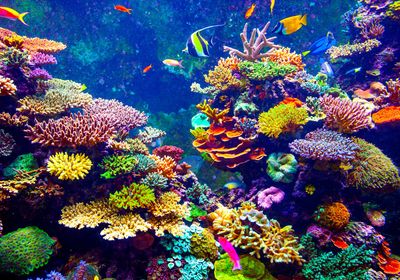A Probiotic to Protect Caribbean Corals
A bacterial strain from healthy corals could slow the progression and prevent transmission of the destructive stony coral tissue loss disease in the wild.
White, lifeless skeletons stand where bright colored corals once existed. That’s the aftermath of stony coral tissue loss disease (SCTLD), a transmissible waterborne disease of unknown cause that has spread across the Caribbean, affecting more than 20 coral species. Antibiotics stop SCTLD progression, but they do not protect corals from reinfection.
Now Valerie Paul, a marine biologist at the Smithsonian Marine Station at Fort Pierce, and her team have found a unique way to fight off SCTLD: treating diseased corals with bacteria from healthy corals. Her findings, published in Communications Biology, reveal a potential option for protecting coral reefs in the wild.1
The study launched when Paul and her team observed that some corals remained uninfected despite being housed near diseased corals of the same species in their lab aquariums. Intrigued, the team investigated the microbiota of healthy corals and isolated a Pseudoalteromonas strain, McH1-7. When the team cocultured McH1-7 with the bacteria from diseased corals, they observed that McH1-7 killed other bacteria. Next, they sequenced DNA from this strain and found a gene cluster tied to a known antimicrobial, korormicin.
The team next tried treating diseased corals with McH1-7 and found that it stopped SCTLD progression in aquarium experiments. Also, healthy corals pretreated with McH1-7 were not infected by SCTLD when exposed to diseased corals.
Since this microbe is already part of the coral’s microbiota, it poses a very low risk for treating corals in the wild, said Kimberly Ritchie, a marine biologist at the University of South Carolina Beaufort who was not involved in the research. “We need to come up with an alternative to antibiotics. Since bacteria are some of the big producers of antibiotics, it makes perfect sense to use nature to help control diseases,” she said.
The next step is to come up with ways to scale up McH1-7 usage in the wild, noted Paul, since it is currently only applicable on a coral-by-coral basis. “The whole problem with the disease is the scale,” Paul said. Since the disease affects thousands of corals, she hopes that they can find a widespread approach for treating many at the same time.
Reference
- Ushijima B, et al. Commun Biol. 2023;6(1):248.


